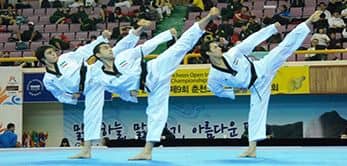
Poomsae
Poomsae are set movements in different directions, with the purpose of bringing the practitioners co-ordination and technique to a higher standard.
WT (World Taekwondo Federation) style Taekwondo has 17 of these forms. 8 are for all students, and the remaining 9 are only for black belts.
From the technical viewpoint, Poomsae is set movements within Taekwondo. Poomsae is the style of movement which expresses the mental and physical requirements of offence and defence, defining movement pattern, coordination, and change of pace. Most importantly it enforces techniques to various body parts and critical points. A set of 17 ‘forms’ each with their own philosophy and purpose, universally identical in WT Taekwondo.
Significance of Poomsae
It can be deducted that the basic movements of Taekwondo are placed in an order, to simulate a real-life situation where one would have to change direction at speed. The Kyorugi (sparring) is a practical application of Poomsae, bringing those actions to a more realistic practical application.
Poomsae is often used to increase the patience of the practitioner. If fighting requires a set of power tools to improve, then Poomsae requires a scalpel. By constantly changing and flowing techniques into each other, the practitioner can improve the power of each individual limb, while increasing their ability to use that power collectively with the whole body. This can only come through practise of the movement until it is grooved into the subconscious; there are no shortcuts to Poomsae.
